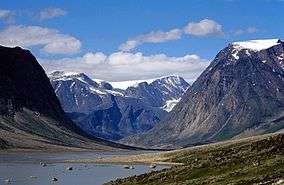Auyuittuq National Park
| Auyuittuq National Park | |
|---|---|
|
IUCN category II (national park) | |
|
Pangnirtung Fiord | |
 Location of Auyuittuq National Park | |
| Location | Nunavut, Canada |
| Nearest city | Pangnirtung, Qikiqtarjuaq |
| Coordinates | 67°53′0″N 65°01′00″W / 67.88333°N 65.01667°WCoordinates: 67°53′0″N 65°01′00″W / 67.88333°N 65.01667°W |
| Area | 19,089 km2 |
| Established | 1976 |
| Governing body | Parks Canada |
Auyuittuq National Park (Inuktitut: ᐊᐅᔪᐃᑦᑐᖅ, IPA: [aujuitːuq], "the land that never melts"[1]) is a national park located on Baffin Island's Cumberland Peninsula, Qikiqtaaluk Region in Nunavut, the largest political subdivision of Canada. It features many terrains of Arctic wilderness, such as fjords, glaciers, and ice fields. Although Auyuittuq was established in 1976 as a national park reserve, it was upgraded to a full national park in 2000.
Little vegetation can be found in Auyuittuq Park, although the plants found there range from flowers such as mountain avens, campion, Papaver, and saxifrage to shrubs like dwarf birch, Arctic willow, and heather. Many of the plants in Auyuittuq Park grow in clumps to create their own warmer "microclimate" to survive the harsh Arctic conditions.
Because of the exceptionally low vegetation supply, wildlife is very scarce. There are only 12 species of mammals that live in Auyuittuq Park including lemmings (both the North American brown lemming and the northern collared lemming), red foxes, snowy owls, peregrine falcons, ermines, rough-legged hawks, gyrfalcons, beluga whales, snow geese, polar bears, wolves, narwhals, Canada geese, Arctic foxes, Arctic hares, and some barren-ground caribou.
The nearest towns are Qikiqtarjuaq and Pangnirtung. Visitors wishing to enter the park are required by Parks Canada to register at the park office in Pangnirtung or Qikiqtarjuaq, and attend an orientation session.[1][2] Park user fees apply.
The most common backpacking route in the park is known as Akshayuk Pass, and follows the Weasel and Owl rivers via Summit Lake. In 2008, heavy rain and warm weather caused Summit Lake to burst through its banks, flooding the Weasel River and washing away the Windy Lake bridge (see photo below). As a result, the hiking routes in the pass are limited to either side of the Weasel River.
Well known peaks include Mount Asgard (shown in the James Bond film The Spy Who Loved Me) with an 800 m (2,600 ft) face, and Mount Thor with a 1,250 m (4,100 ft), 105° face.
Gallery
-

Mount Asgard, Baffin Island, 2001
-

Maktak Fiord Delta
-

Horseshoe-shaped lateral moraines at the margin of the Penny Ice Cap
-
Along the Weasel River, hiking to Mount Thor
-

Rock formations and glaciers
-

Baffin Mountains from the air, Cumberland Peninsula
See also
References
- 1 2 Auyuittuq National Park
- ↑ Visitor Information Package Archived October 18, 2013, at the Wayback Machine.
Further reading
- Ferguson, Steven H; Taylor, Mitchell K; Messier, Francois (1997). "Space Use by Polar Bears in and Around Auyuittuq National Park, Northwest Territories, During the Ice-Free Period". Canadian Journal of Zoology. 75 (10): 1585–1595. doi:10.1139/z97-785.
- Hines, James E.; Moore, Steve (1988). The Vegetation and Flora of Auyuittuq National Park Reserve, Baffin Island (PDF) (Report). Yellowknife, Canada: Department of Renewable Resources, Government of the Northwest Territories. Retrieved 2015-05-22.
- Konotepetz, Larry (1985). Archaeological Sites of Auyuittuq National Park Reserve. Microfiche report series, 315. Ottawa, Canada: Environment Canada, Canadian Parks Service. OCLC 59739479.
- Masterton, J. M.; Findlay, B. F. (September 1976). The Climate of Auyuittuq National Park, Baffin Island, Northwest Territories (PDF) (Report). Toronto, Canada: Atmospheric Environment Service, Meteorological Applications Branch, Environment Canada.
- Tarnocai, C. (1998). Monitoring the Integrity of Cultural Sites, Auyuittuq National Park Reserve (Report). Ottawa, Canada: Research Branch (ECORC), Agriculture and Agri-Food Canada.
- Wilson, Roger, ed. (1976). The Land That Never Melts Auyuittuq National Park. Toronto: Peter Martin Associates Limited in association with Indian and Northern Affairs and Pub. Centre, Supply and Services Canada. ISBN 0-88778-143-8.
External links
| Wikimedia Commons has media related to Auyuittuq National Park. |
- Parks Canada official site
- Mount Thor Peak climbing info
- Information and pictures - from The Tulugak Hotel
- Auyuittuq National Park Information
- Newspaper article about Auyuittuq National Park by Dallas Morning News reporter Dave Levinthal

